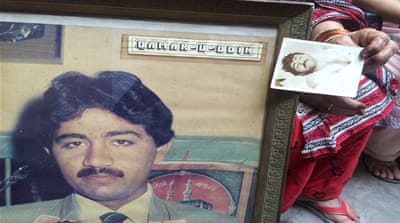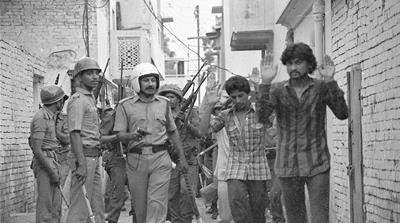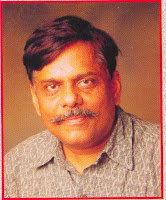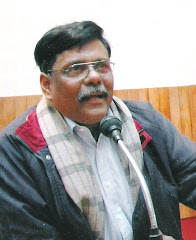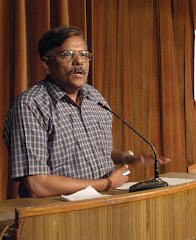Friday, April 3, 2015
हाशिमपुरा के अन्याय मे सभी दोषी -विभूति नारायण राय -अमर उजाला
हाशिमपुरा के अन्याय मे सभी दोषी -विभूति नारायण रायहाशिमपुरा का नरसंहार स्वतंत्रता बाद की सबसे बड़ी कस्टोडियन किलिंग (हिरासत में मौत) की घटना है। इसके पहले जहां तक मुझे याद है, कभी इतनी बड़ी संख्या में पुलिस ने अपनी हिरासत में लेकर लोगों को नहीं मारा था। इसके बावजूद एक भी अपराधी को दंडित नहीं किया जा सका। अदालत के फैसले से मुझे कोई आश्चर्य नहीं हुआ है। मैंने पहले ही दिन से यही अपेक्षा की थी। दरअसल भारतीय राज्य का कोई भी स्टेक होल्डर नहीं चाहता था कि दोषियों को सजा मिले। राजनीतिक नेतृत्व, नौकरशाही, वरिष्ठ पुलिस अधिकारी, मीडिया-सभी ने 22 मई, 1987 से ही इस मामले की गंभीरता को कम करने की कोशिश की थी। भारतीय न्याय प्राणाली की चिंता का आलम यह है कि इतने जघन्य मामले का फैसला करने में अदालतों को लगभग अट्ठाइस साल लग गए।
For nearly two decades, Rai has been conducting his own investigation into the Hashimpura case for his book. “If I could talk to her as an author and get a lot more information, I find no reason to believe that the CID, in its capacity as a legal authority, could do nothing to test the veracity of the suspicions of killings being a means at personal retribution.”
HUMAN RIGHTS
No justice 28 years after massacre of Indian Muslims
Recent court ruling finds police unit not guilty of rounding up and executing 42 Muslim men during 1987 communal riots.

Meerut, India - The Massacre took place on May 22, 1987th, the Muslim holy month of the Last Friday of Ramadan.
The families of Hashimpura - a predominantly Muslim locality in the city of Meerut, 75km northeast of New Delhi in the state of Uttar Pradesh - had retreated to their homes to break fast.
Dusk transformed into night in relative peace - until armed officers started charging into homes, rounding up as many able-bodied men as they could.
"They burst inside the house, went inside, upstairs, everywhere shouting, 'Where are your men, where are your men?'" Zapun Begum told Al Jazeera from the courtyard of her home, her eyes cast downward.
A framed wedding portrait of her then-22-year-old son, Qamar-u-ddin, rested against the side of the plastic lawn chair in which she sat. In her wrinkled hands, she held a small photograph showing his body after it emerged from the river in which it was dumped: chest bare, eyes shut, body wrapped like a mummy.
Her other four sons were able to get away, but it was her eldest that received the same fate as 41 other Muslim men in what's become known as the "Hashimpura massacre" - a 28-year-old mass murder that only reached a verdict days ago despite its age.
Drawn out trial
A New Delhi court last Saturday acquitted 16 Uttar Pradesh police personnel charged with abducting some 50 men of Hashimpura that night, driving them away in a yellow truck, shooting them, and dumping 42 bodies into the river.
Prosecutors allege the police officers were part of a state police unit called the Provincial Armed Constabulary (PAC).
"It was a joint operation of the army, the local police, the PAC and the central reserve police force," Satish Tamta, the special prosecutor appointed to the case in 2008, told Al Jazeera.
What happened that night in Meerut was an isolated incident no one anticipated. But the city had a history of communal flare-ups every few years, and that time in particular was tense.
A year earlier, then-prime minister Rajiv Gandhi opened up the gates of the Babri Masjid for Hindu worship. The site of the famous mosque, located in the Uttar Pradesh city of Ayodhya, has long been a contention for Hindus and Muslims.
Hindus say it is the birthplace of Lord Ram. The Vishwa Hindu Parishad, a right-wing Hindu nationalist group, had laid claims to the mosque site since the late 1970s. By the Time Gandhi opened it in the 1,986th, both communities were on the Issue Highly polarized.
Religious riots
Clashes between Hindus and Muslims erupted in Meerut and its surrounding areas in the days preceding the Hashimpura massacre. A curfew was put in place, along with "regular checking."
"During communal riots, the normal practice is that people are searched and their houses are searched for any legal or illegal weapons," said Vibhuti Narain Rai, the then-superintendent of police in neighbouring Ghaziabad district, who has written a book on the massacre .
Jailing people the police suspected might incite violence was also routine.
Different Law Enforcement Agencies to conduct the searches and Arrests Collaborated in Night RIOT-affected areas that, according to the Court ' s Charge SHEET.
"There were riots happening in Meerut, but not in Hashimpura," Zulfiqar Nasir, one of five survivors of the massacre, told Al Jazeera.
Some allege police prejudice led to the killings.
"The PAC at that time was known as an anti-Muslim police force," said Zafaryab Jilani, a legal advisor to the All India Muslim Personal Law Board and leader of the Babri Masjid Action Committee. "They do not come to action by themselves ... The local police generally calls the PAC because its numbers are not sufficient."
Revenge attack?
According to the English translation of the court's charge sheet, "some unsocial elements" had attempted to murder a member of the PAC, and seized two guns from PAC officers.
A Hindu boy was also killed in the violence, leading some to believe the massacre may have been a form of revenge.
"He [the Hindu boy] was standing on the roof of his house and a bullet came from the side of Hashimpura and struck him," the former police superintendent Rai said. "It was an understanding that he had been killed by a Muslim."
Yet these incidents Staged ARE likely to have been, said Paul Brass, A Researcher on South Asian politics and author of the Book of The Hindu-Muslim Violence in Contemporary India Production .
"So-called 'tensions' are deliberate acts of provocation, staged by the BJP cadres, mostly at election times," Brass told Al Jazeera, referring to the Bharatiya Janata Party, the political arm of India's Hindu nationalist movement.
Photojournalist Praveen Jain had come to Meerut from New Delhi that day to photograph the ongoing communal riots. He instead captured the unfolding action before the Hashimpura massacre.
"They were crying and begging, 'Leave us we are innocent," Jain told Al Jazeera. "And the army handed over these innocent people to the PAC."
The judge last Saturday cleared the 16 accused PAC personnel - originally 19 before three died - saying there was not enough evidence to prove their responsibility for the massacre.
Defence lawyer LD Mual said the Provincial Armed Constabulary unit was made a "scapegoat" and the judgment was based upon the evidence presented in the case files.
"As far as the investigation of the case is concerned, the subject matter is with the state," Mual told Al Jazeera.
'Ties of the khaki'
Critics argue the handling of the investigation, which took nine years to complete, shows authorities purposefully delayed the case to protect the assailants.
The "Fraternal TIES of the khaki," - police Officers wear khaki uniforms - they must also do Overshadow any Investigations on each other, said vrinda Grover, A victims ' Lawyer.
"Under Indian law, it is the state that is the investigating and prosecuting agency," Grover said. "If the state is with the accused, then the exact framework in which justice should be delivered will be badly shaken."
The holes in the two-decade-long investigation might have been explained better had the right sources been available as well, said Tamta, the special prosecutor for the case.
"Two of the major investigating officers of the case had died during the course of the trial, and so there was no one to tell the missing links to complete the story."
Ramesh Dixit, a retired professor of political science at Lucknow University, pointed out that lawyers assigned to the case changed many times, until victims' families petitioned for the case's transfer to New Delhi in 2002.
"It's the police forces, bureaucracy, and also those political personalities who just try to hush up everything," Dixit said. "It's a shame on the state."
Victims' families and survivors are now planning to appeal.
Grover said the issue must be raised outside the court as well. "There are serious issues of how the legal system is functioning and not delivering justice repeatedly in the cases of mass crimes and targeted killings," she said.
Mohammed Qadir, whose father was killed in the massacre - his body never recovered - said the families have waited too long for answers.
"But if they [PAC] did not kill them, who did? It's the state's responsibility to tell us," said Qadir.
Source: Al Jazeera
Subscribe to:
Posts (Atom)
